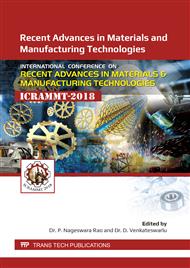[1]
R.R. Rashid, S. Palanisamy, S. Sun, M. Dargusch, Tool wear mechanisms involved in crater formation on uncoated carbide tool when machining Ti6Al4V alloy, Int. J. Adv. Manuf. Technol. 83 (2016) 1457-1465.
DOI: 10.1007/s00170-015-7668-z
Google Scholar
[2]
A. Pramanik, G. Littlefair, Machining of titanium alloy (Ti-6Al-4V)—theory to application, Mater. Sci. Technol. 19 (2015) 1-49.
DOI: 10.1080/10910344.2014.991031
Google Scholar
[3]
T. Galeta, G. Šimunovic, M. Mazurek, Impact of strengthening fluids on roughness of 3D printed models, Metalurgija 54 (2015) 231-234.
Google Scholar
[4]
J. Novak-Marcincin, J. Torok, L. Novakova-Marcincinova, J. Barna, M. Janak, use of alternative scanning devices for creation of 3d models of machine parts, Tehnickivjesnik/Technical Gazette 21 (2014).
DOI: 10.1109/coginfocom.2012.6421957
Google Scholar
[5]
P. Kumar, J.P. Misra, A Surface Roughness Predictive Model for DSS Longitudinal Turning Operation, in: B. Katalinic (Ed.), DAAAM International Scientific Book 2018, Published by DAAAM International, Vienna, 2018, pp.285-296.
DOI: 10.2507/daaam.scibook.2018.25
Google Scholar
[6]
J. Jozwik, P. Piesko, G. Krajewski, Evaluation of QC10 ball bar diagnostics method for CNC machine, Eksploatacja I Niezawodnosc-Maintenance and Reliability (2010) 10-20.
Google Scholar
[7]
A. Glowacz, Diagnostics of direct current machine based on analysis of acoustic signals with the use of symlet wavelet transform and modified classifier based on words, EksploatacjaiNiezawodnosc 16 (2014).
Google Scholar
[8]
A. Glowacz, P. Korohoda, Recognition of monochrome thermal images of synchronous motor with the application of binarization and nearest mean classifier, Arch. Metall. Mater. 59 (2014) 31-34.
DOI: 10.2478/amm-2014-0005
Google Scholar
[9]
P.-J. Arrazola, A. Garay, L.-M.Iriarte, M. Armendia, S. Marya, F. Le Maitre, Machinability of titanium alloys (Ti6Al4V and Ti555. 3), J. Mater. Process. Technol. 209 (2009) 2223-2230.
DOI: 10.1016/j.jmatprotec.2008.06.020
Google Scholar
[10]
G. Ibrahim, C.C. Haron, J.A. Ghani, The effect of dry machining on surface integrity of titanium alloy Ti-6Al-4V ELI, Journal of Applied Sciences 9 (2009) 121-127.
DOI: 10.3923/jas.2009.121.127
Google Scholar
[11]
A. Jawaid, C. Che-Haron, A. Abdullah, Tool wear characteristics in turning of titanium alloy Ti-6246, J. Mater. Process. Technol. 92 (1999) 329-334.
DOI: 10.1016/s0924-0136(99)00246-0
Google Scholar


